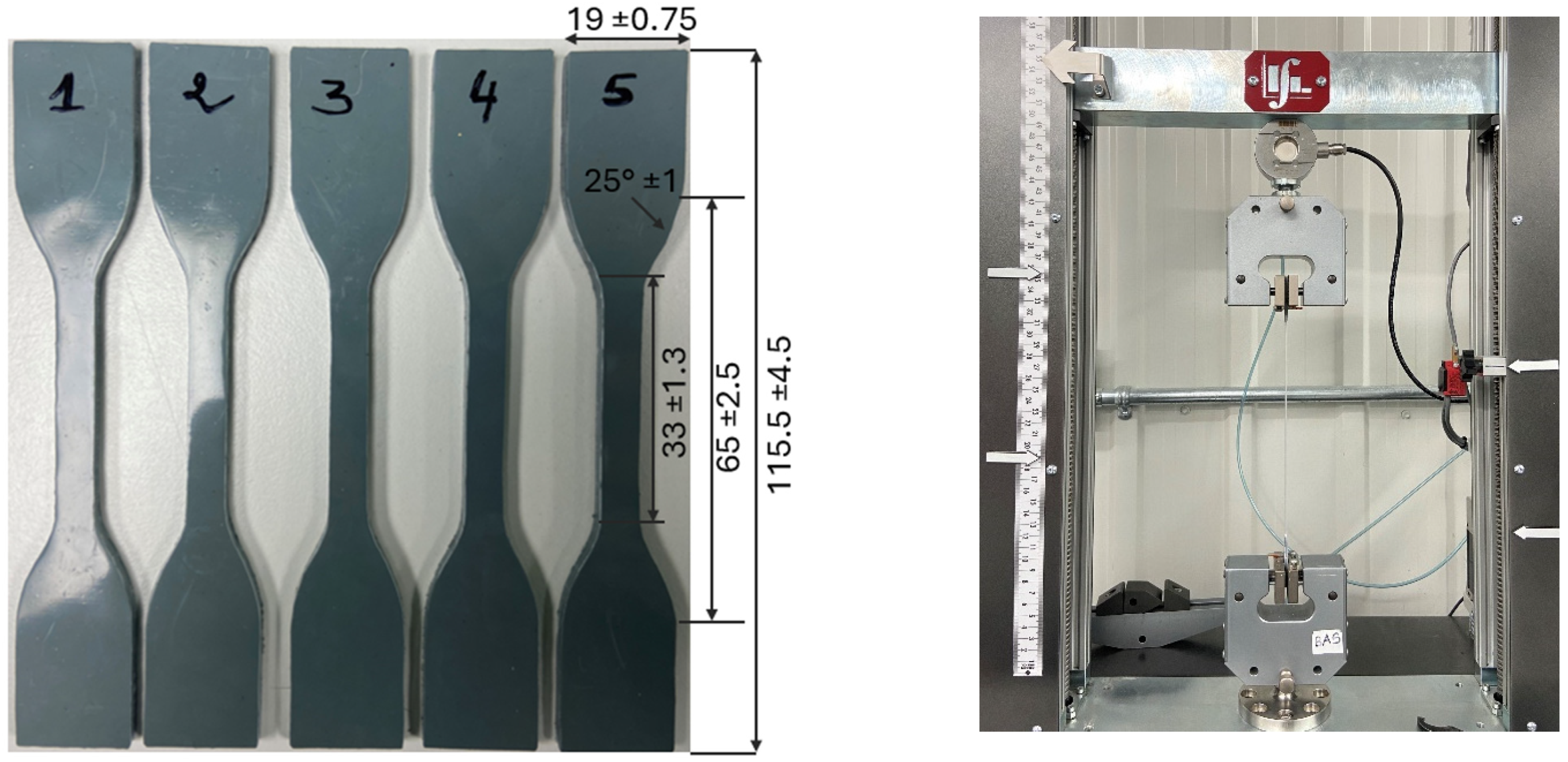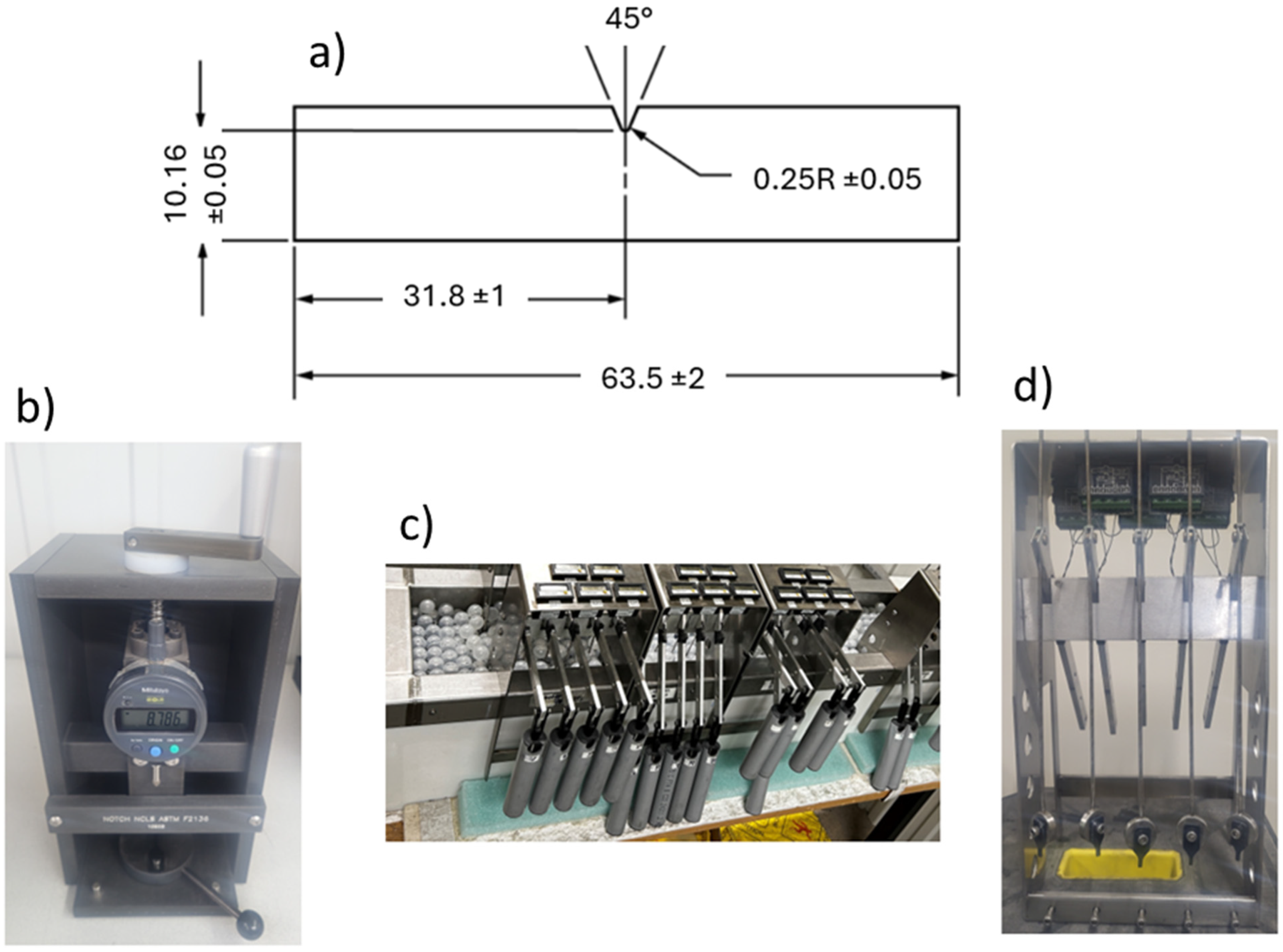Effect of Graphene on the Mechanical Properties of Recycled High-Density and High-Molecular-Weight Polyethylene Blends
Abstract
:1. Introduction
2. Materials and Methods
2.1. Materials
2.1.1. Polyethylene
2.1.2. Graphene
2.2. Methods
2.2.1. Preparation of Blends
2.2.2. Samples Preparation
2.3. Physical Characterization
2.3.1. Mechanical Properties
2.3.2. Thermal Properties
2.3.3. Rheological Properties
3. Results and Discussion
3.1. Melt Flow Index (MFI)
3.2. Tensile and Flexion Test
3.3. Stress Crack Resistance
3.4. Impact Strength Resistance
3.5. Thermal Behavior
4. Conclusions
Author Contributions
Funding
Institutional Review Board Statement
Informed Consent Statement
Data Availability Statement
Acknowledgments
Conflicts of Interest
References
- Organisation for Economic Co-Operation and Development. Global Plastic Production from 1950 to 2022; Organisation for Economic Co-Operation and Development: Paris, France, 2023. [Google Scholar]
- Borrelle, S.B.; Ringma, J.; Law, K.L.; Monnahan, C.C.; Lebreton, L.; McGivern, A.; Murphy, E.; Jambeck, J.; Leonard, G.H.; Hilleary, M.A. Predicted growth in plastic waste exceeds efforts to mitigate plastic pollution. Science 2020, 369, 1515–1518. [Google Scholar] [CrossRef] [PubMed]
- Walker, T.R.; Fequet, L. Current trends of unsustainable plastic production and micro(nano)plastic pollution. TrAC Trends Anal. Chem. 2023, 160, 116984. [Google Scholar] [CrossRef]
- Vanapalli, K.R.; Sharma, H.B.; Ranjan, V.P.; Samal, B.; Bhattacharya, J.; Dubey, B.K.; Goel, S. Challenges and strategies for effective plastic waste management during and post COVID-19 pandemic. Sci. Total Environ. 2021, 750, 141514. [Google Scholar] [CrossRef]
- Francis, R. Recycling of Polymers: Methods, Characterization and Applications; John Wiley & Sons: Hoboken, NJ, USA, 2016; ISBN 3-527-33848-9. [Google Scholar]
- Diallo, A.K.; Helal, E.; Gutierrez, G.; Madinehei, M.; David, E.; Demarquette, N.; Moghimian, N. Graphene: A multifunctional additive for sustainability. Sustain. Mater. Technol. 2022, 33, e00487. [Google Scholar] [CrossRef]
- Luzuriaga, S.; Kovářová, J.; Fortelný, I. Degradation of pre-aged polymers exposed to simulated recycling: Properties and thermal stability. Polym. Degrad. Stab. 2006, 91, 1226–1232. [Google Scholar] [CrossRef]
- Patlolla, V.R.; Asmatulu, R. Recycling and Reusing Fiber-Reinforced Composites. Environ. Res. J. 2013, 7, 145. [Google Scholar]
- Ambrogi, V.; Carfagna, C.; Cerruti, P.; Marturano, V. 4—Additives in Polymers. In Modification of Polymer Properties; Jasso-Gastinel, C.F., Kenny, J.M., Eds.; William Andrew Publishing: Norwich, NY, USA, 2017; pp. 87–108. ISBN 978-0-323-44353-1. [Google Scholar]
- Blokhina, O.; Virolainen, E.; Fagerstedt, K.V. Antioxidants, oxidative damage and oxygen deprivation stress: A review. Ann. Bot. 2003, 91, 179–194. [Google Scholar] [CrossRef]
- La Mantia, F.P. The role of additives in the recycling of polymers. In Macromolecular Symposia; Wiley Online Library: Hoboken, NJ, USA, 1998; Volume 135, pp. 157–165. [Google Scholar]
- Huang, J.-C. Carbon black filled conducting polymers and polymer blends. Adv. Polym. Technol. J. Polym. Process. Inst. 2002, 21, 299–313. [Google Scholar] [CrossRef]
- Korkees, F.; Aldrees, A.; Barsoum, I.; Alshammari, D. Functionalised graphene effect on the mechanical and thermal properties of recycled PA6/PA6,6 blends. J. Compos. Mater. 2021, 55, 2211–2224. [Google Scholar] [CrossRef]
- Mittal, G.; Dhand, V.; Rhee, K.Y.; Park, S.-J.; Lee, W.R. A review on carbon nanotubes and graphene as fillers in reinforced polymer nanocomposites. J. Ind. Eng. Chem. 2015, 21, 11–25. [Google Scholar] [CrossRef]
- Liu, M.; Kinloch, I.A.; Young, R.J.; Papageorgiou, D.G. Modelling mechanical percolation in graphene-reinforced elastomer nanocomposites. Compos. Part B Eng. 2019, 178, 107506. [Google Scholar] [CrossRef]
- Novoselov, K.S.; Geim, A.K.; Morozov, S.V.; Jiang, D.; Zhang, Y.; Dubonos, S.V.; Grigorieva, I.V.; Firsov, A.A. Electric field effect in atomically thin carbon films. Science 2004, 306, 666–669. [Google Scholar] [CrossRef] [PubMed]
- Wang, J.; Jin, X.; Li, C.; Wang, W.; Wu, H.; Guo, S. Graphene and graphene derivatives toughening polymers: Toward high toughness and strength. Chem. Eng. J. 2019, 370, 831–854. [Google Scholar] [CrossRef]
- Verma, A.; Parashar, A.; Packirisamy, M. Effect of grain boundaries on the interfacial behaviour of graphene-polyethylene nanocomposite. Appl. Surf. Sci. 2019, 470, 1085–1092. [Google Scholar] [CrossRef]
- Idowu, A.; Boesl, B.; Agarwal, A. 3D graphene foam-reinforced polymer composites—A review. Carbon 2018, 135, 52–71. [Google Scholar] [CrossRef]
- Bianco, A.; Cheng, H.-M.; Enoki, T.; Gogotsi, Y.; Hurt, R.H.; Koratkar, N.; Kyotani, T.; Monthioux, M.; Park, C.R.; Tascon, J.M. All in the Graphene Family–A Recommended Nomenclature for Two-Dimensional Carbon Materials; Elsevier: Amsterdam, The Netherlands, 2013; Volume 65, pp. 1–6. ISBN 0008-6223. [Google Scholar]
- Nieto, A.; Boesl, B.; Agarwal, A. Multi-scale intrinsic deformation mechanisms of 3D graphene foam. Carbon 2015, 85, 299–308. [Google Scholar] [CrossRef]
- Wei, W.; Qu, X. Extraordinary physical properties of functionalized graphene. Small 2012, 8, 2138–2151. [Google Scholar] [CrossRef]
- Liem, H.; Choy, H.S. Superior thermal conductivity of polymer nanocomposites by using graphene and boron nitride as fillers. Solid State Commun. 2013, 163, 41–45. [Google Scholar] [CrossRef]
- Lee, C.; Wei, X.; Kysar, J.W.; Hone, J. Measurement of the Elastic Properties and Intrinsic Strength of Monolayer Graphene. Science 2008, 321, 385–388. [Google Scholar] [CrossRef]
- Khan, Z.U.; Kausar, A.; Ullah, H.; Badshah, A.; Khan, W.U. A review of graphene oxide, graphene buckypaper, and polymer/graphene composites: Properties and fabrication techniques. J. Plast. Film Sheeting 2016, 32, 336–379. [Google Scholar] [CrossRef]
- Sarker, F.; Potluri, P.; Afroj, S.; Koncherry, V.; Novoselov, K.S.; Karim, N. Ultrahigh performance of nanoengineered graphene-based natural jute fiber composites. ACS Appl. Mater. Interfaces 2019, 11, 21166–21176. [Google Scholar] [PubMed]
- Sarker, F.; Karim, N.; Afroj, S.; Koncherry, V.; Novoselov, K.S.; Potluri, P. High-performance graphene-based natural fiber composites. ACS Appl. Mater. Interfaces 2018, 10, 34502–34512. [Google Scholar] [CrossRef]
- Wang, L.; Hong, J.; Chen, G. Comparison study of graphite nanosheets and carbon black as fillers for high density polyethylene. Polym. Eng. Sci. 2010, 50, 2176–2181. [Google Scholar] [CrossRef]
- Yasmin, A.; Luo, J.-J.; Daniel, I.M. Processing of expanded graphite reinforced polymer nanocomposites. Compos. Sci. Technol. 2006, 66, 1182–1189. [Google Scholar]
- Gupta, S.; Raju Mantena, P.; Al-Ostaz, A. Dynamic mechanical and impact property correlation of nanoclay and graphite platelet reinforced vinyl ester nanocomposites. J. Reinf. Plast. Compos. 2010, 29, 2037–2047. [Google Scholar]
- ASTM D792-20; Standard Test Methods for Density and Specific Gravity (Relative Density) of Plastics by Displacement. ASTM International: West Conshohocken, PA, USA, 2020.
- ASTM D1238-13; Standard Test Method for Melt Flow Rates of Thermoplastics by Extrusion Plastometer. ASTM International: West Conshohocken, PA, USA, 2013.
- ASTM D638-14; U.S. Department of Defense Standard Test Method for Tensile Properties of Plastics 2014. ASTM International: West Conshohocken, PA, USA, 2014.
- ASTM D790-17; U.S. Department of Defense Standard Test Methods for Flexural Properties of Unreinforced and Reinforced Plastics and Electrical Insulating Materials 2017. ASTM International: West Conshohocken, PA, USA, 2017.
- ASTM F2136-18; Standard Test Method for Notched, Constant Ligament-Stress (NCLS) Test to Determine Slow-Crack-Growth Resistance of HDPE Resins or HDPE Corrugated Pipe. ASTM International: West Conshohocken, PA, USA, 2024.
- ASTM D256-10; Standard Test Methods for Determining the Izod Pendulum Impact Resistance of Plastics. ASTM International: West Conshohocken, PA, USA, 2018.
- ASTM D3895-14; Standard Test Method for Oxidative-Induction Time of Polyolefins by Differential Scanning Calorimetry. ASTM International: West Conshohocken, PA, USA, 2014.
- Beigloo, J.G.; Eslam, H.K.; Hemmasi, A.H.; Bazyar, B.; Ghasemi, I. Effect of nanographene on physical, mechanical, and thermal properties and morphology of nanocomposite made of recycled high density polyethylene and wood flour. BioResources 2017, 12, 1382–1394. [Google Scholar]
- Farsi, M.; Younesi, K.H. Effect of single wall carbon nanotubes on physical and mechanical properties of wood fiber-LDPE composites. J. For. Wood Prod. 2012, 65, 169–186. [Google Scholar]
- Sheshmani, S.; Amini, R. Preparation and characterization of some graphene based nanocomposite materials. Carbohydr. Polym. 2013, 95, 348–359. [Google Scholar] [CrossRef]
- Papageorgiou, D.G.; Kinloch, I.A.; Young, R.J. Mechanical properties of graphene and graphene-based nanocomposites. Prog. Mater. Sci. 2017, 90, 75–127. [Google Scholar] [CrossRef]
- Umesh, G.L.; Prasad, N.J.K.; Rudresh, B.M.; Devegowda, M. Influence of nano graphene on mechanical behavior of PA66/PA6 blend based hybrid nano composites: Effect of micro fillers. Mater. Today Proc. 2020, 20, 228–235. [Google Scholar] [CrossRef]
- Slovokhotova, N.A.; Magrupov, M.A.; Kargin, V.A. Thermal degradation of polyethylene. Polym. Sci. U.S.S.R. 1964, 6, 2186–2192. [Google Scholar] [CrossRef]
- Wunderlich, B. Thermal Analysis; Academic Press: New York, NY, USA, 1990; pp. 417–431. [Google Scholar]






| Composition | Loading (wt%) | |
|---|---|---|
| Carrier | MDPE | 70 |
| Filler | Graphene Black | 30 |
| Element | Value (wt%) |
|---|---|
| Carbon | >97 |
| Oxygen | <1 |
| Property | Value (SI) | Test Method |
|---|---|---|
| Density | 1.12 g/ | ASTM D792 [31] |
| Fluidity | 8 g/10 min | ASTM D1238 [32] |
| Blend Number | recHDPE (wt%) | recHMWPE (wt%) | Graphene (wt%) |
|---|---|---|---|
| 1 | 35 | 65 | - |
| 2 | 35 | 64.5 | 0.5 |
| 3 | 35 | 64 | 1 |
| Sample | Melt Peak Temperature (°C) | Meling Enthalpy (J/g) | Crystallinity (%) |
|---|---|---|---|
| Reference | 129.4 | 135.3 | 46.2 |
| 0.5% Graphene | 131.5 | 138.5 | 47.3 |
| 1% Graphene | 130.6 | 144.7 | 49.4 |
Disclaimer/Publisher’s Note: The statements, opinions and data contained in all publications are solely those of the individual author(s) and contributor(s) and not of MDPI and/or the editor(s). MDPI and/or the editor(s) disclaim responsibility for any injury to people or property resulting from any ideas, methods, instructions or products referred to in the content. |
© 2024 by the authors. Licensee MDPI, Basel, Switzerland. This article is an open access article distributed under the terms and conditions of the Creative Commons Attribution (CC BY) license (https://creativecommons.org/licenses/by/4.0/).
Share and Cite
Kharmoudi, H.; Lamtai, A.; Elkoun, S.; Robert, M.; Diez, C. Effect of Graphene on the Mechanical Properties of Recycled High-Density and High-Molecular-Weight Polyethylene Blends. Materials 2024, 17, 4733. https://doi.org/10.3390/ma17194733
Kharmoudi H, Lamtai A, Elkoun S, Robert M, Diez C. Effect of Graphene on the Mechanical Properties of Recycled High-Density and High-Molecular-Weight Polyethylene Blends. Materials. 2024; 17(19):4733. https://doi.org/10.3390/ma17194733
Chicago/Turabian StyleKharmoudi, Hniya, Alae Lamtai, Said Elkoun, Mathieu Robert, and Carl Diez. 2024. "Effect of Graphene on the Mechanical Properties of Recycled High-Density and High-Molecular-Weight Polyethylene Blends" Materials 17, no. 19: 4733. https://doi.org/10.3390/ma17194733










